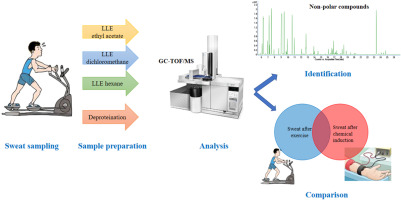Talanta ( IF 6.1 ) Pub Date : 2017-09-15 , DOI: 10.1016/j.talanta.2017.09.028 M.M. Delgado-Povedano , M. Calderón-Santiago , M.D. Luque de Castro , F. Priego-Capote

|
Sweat is a promising biofluid scarcely used in clinical analysis despite its non-invasive sampling. A more frequent clinical use of sweat requires to know its whole composition, especially concerning to non-polar compounds, and the development of analytical strategies for its characterization. The aim of the present study was to compare different sample preparation strategies to maximize the detection of metabolites in sweat from humans collected after practicing moderate exercise. Special emphasis was put on non-polar compounds as they have received scant attention in previous studies dealing with this biofluid. Sample preparation by liquid–liquid extraction (LLE) using extractants with different polarity index was compared to deproteination. Then, derivatization by methoxymation with subsequent silylation was compared to direct analysis of sweat extracts to check the influence of derivatization on the subsequent determination of volatile organic compounds (VOCs). 135 compounds were tentatively identified by combining spectral and retention time information after analysis by gas chromatography coupled to mass spectrometry in high resolution mode (GC–TOF/MS). Lipids, VOCs, benzenoids and other interesting metabolites such as alkaloids and ethanolamines were identified. Among the tested protocols, methyoxiamination plus silylation after LLE with dichloromethane was the best option to obtain a representative snapshot of sweat metabolome collected from different body parts after moderate exercise. Passive and active sweat pools from a cohort of volunteers (n = 6) were compared to detect compositional differences which can be explained by the sampling process and sweating induction. As most of the identified compounds are metabolites involved in key biochemical pathways, this study opens new opportunities to extend the applicability of human sweat as a source of metabolite biomarkers of pathologies or specific processes such as dehydration or nutritional unbalance.
中文翻译:

中度运动后人体汗液的代谢组学分析
汗液是一种很有前途的生物流体,尽管它是非侵入性采样,但很少用于临床分析。临床上更频繁地使用汗水需要了解其全部成分,尤其是与非极性化合物有关的成分,并需要了解其表征的分析策略。本研究的目的是比较不同的样品制备策略,以最大程度地检测出在进行适度运动后从人体中收集的汗液中代谢物的含量。非极性化合物特别受关注,因为它们在先前有关这种生物流体的研究中很少受到关注。将使用不同极性指数的萃取剂通过液-液萃取(LLE)进行的样品制备与脱蛋白进行了比较。然后,将甲氧基化衍生化和随后的甲硅烷基化与汗液提取物的直接分析进行比较,以检查衍生化对挥发性有机化合物(VOC)后续测定的影响。通过将质谱和气相色谱-质谱联用以高分辨率模式(GC-TOF / MS)分析后,结合光谱和保留时间信息,初步鉴定出135种化合物。鉴定了脂质,VOC,苯类化合物和其他有趣的代谢物,如生物碱和乙醇胺。在经过测试的方案中,LLE与二氯甲烷混合后进行甲氧氰化加甲硅烷基化是获得适度运动后从不同身体部位收集的汗液代谢组的代表性快照的最佳选择。一群志愿者的被动和主动汗液池(通过将质谱和气相色谱-质谱联用以高分辨率模式(GC-TOF / MS)分析后,结合光谱和保留时间信息,初步鉴定出135种化合物。鉴定了脂质,VOC,苯类化合物和其他有趣的代谢物,如生物碱和乙醇胺。在经过测试的方案中,LLE与二氯甲烷混合后进行甲氧氰化加甲硅烷基化是获得适度运动后从不同身体部位收集的汗液代谢组代表性快照的最佳选择。一群志愿者的被动和主动汗液池(通过将质谱和气相色谱-质谱联用以高分辨率模式(GC-TOF / MS)分析后,结合光谱和保留时间信息,初步鉴定出135种化合物。鉴定了脂质,VOC,苯类化合物和其他有趣的代谢物,如生物碱和乙醇胺。在经过测试的方案中,LLE与二氯甲烷混合后进行甲氧氰化加甲硅烷基化是获得适度运动后从不同身体部位收集的汗液代谢组的代表性快照的最佳选择。一群志愿者的被动和主动汗液池(进行适度运动后,使用LELE和二氯甲烷进行甲氧肟酸加甲硅烷基化是获得从不同身体部位收集的汗液代谢组的代表性快照的最佳选择。一群志愿者的被动和主动汗液池(进行适度运动后,使用LELE和二氯甲烷进行甲氧肟酸加甲硅烷基化是获得从不同身体部位收集的汗液代谢组的代表性快照的最佳选择。一群志愿者的被动和主动汗液池(比较n = 6)来检测成分差异,这可以通过采样过程和出汗来解释。由于大多数鉴定出的化合物是参与关键生化途径的代谢物,因此本研究为扩大人类汗液作为病理或特定过程(如脱水或营养失衡)的代谢物生物标志物来源提供了新的机会。



























 京公网安备 11010802027423号
京公网安备 11010802027423号